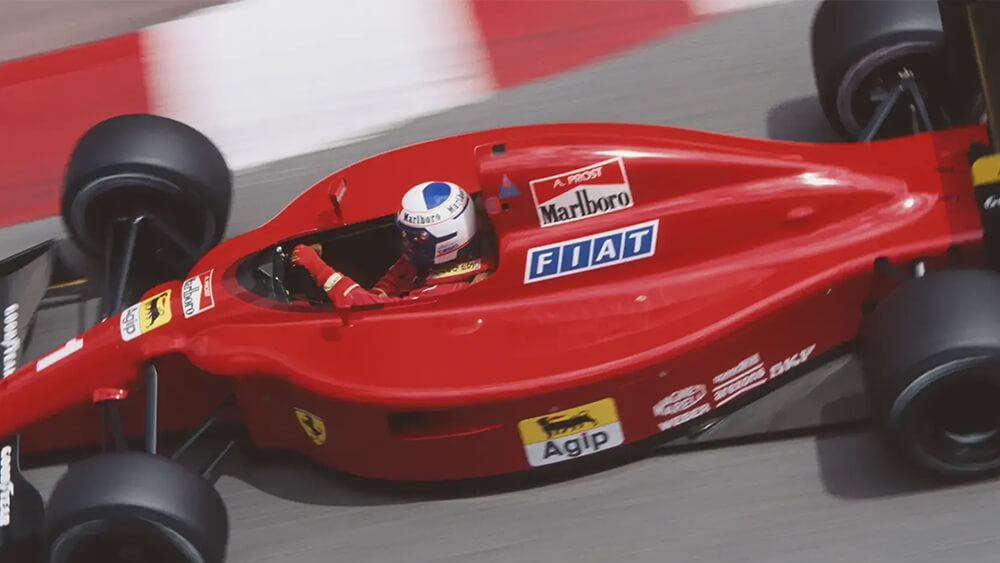There’s a saying in motor racing that a good looking car is usually a quick car. There are exceptions of course, but Scuderia Ferrari’s challenger for the 1990 Formula 1 season definitely fits the description. The F1-90, which went by the Codename 641 when it was at the design stage, is widely regarded as one of the most beautiful race cars of all time.
At the end of the previous season, there was no real clue that Ferrari would be in the hunt for the title, given they had finished third in the 1989 championship, trailing the winning McLaren team by over 80 points. On top of that, the English designer John Barnard, who had been allowed to work for Ferrari from his UK base, having been poached from McLaren, had quit the team at the end of the year to join Benetton. It meant the job of developing the F1-90 now fell to another former McLaren man, the American Steve Nichols, abetted.
The beautiful beating heart of the car was its 3.5 litre V12, although it gave away a slight power advantage to the Hondas and Renaults and had less torque to power out of slow corners. But the chassis and aerodynamics made up for its deficiencies and Alain Prost, who made the switch from McLaren to get away from Ayrton Senna for 1990, declared it was the best car of the year. Not surprising really, as Nichols, having worked with the Frenchman at McLaren had ensured the F1-90 suited his ultra-smooth driving style. Prost also put in a lot of testing miles ensuring that the revolutionary semi-automatic paddle-shift 7 speed gearbox, first seen the previous year. The aerodynamics were also tweaked and the wheelbase was longer than the ’89 model. Aware it was lacking slightly in horsepower compared to the opposition, as early as the third round of the season, the San Marino Grand Prix at Imola, a new version of the engine was introduced, combined with a larger fuel tank to deal with the fact it’s 12 cylinders made it a truly thirsty beast.
 Alain Prost in the F1-90 at San Marino GP in 1990. Image courtesy Wilhelm Wolfgang
Alain Prost in the F1-90 at San Marino GP in 1990. Image courtesy Wilhelm Wolfgang
The two most memorable moments in the F1-90’s career reflected contrasting fortunes. Although Nigel Mansell only scored one win to Prost’s five that year, it was the Englishman’s pass on Gerhard Berger in Mexico that showed just what he and the F1-90 were capable of, as he passed the Austrian in the McLaren round the outside of the infamous Peraltada corner, a move considered pretty much impossible. Mansell reckoned it was one of the greatest overtaking moves of his career and no one would disagree with him. While Mansell and Prost amassed sufficient points to give Ferrari the Constructors’ title for the first time in seven year, the Frenchman’s unforgettable moment in the F1-90 was a controversial one. At the penultimate race at Japan’s Suzuka circuit, Ayrton Senna took pole in the McLaren with Prost second, but the officials insisted that pole was on the dirty side of the track, much to the Brazilian’s disgust. Sure enough, when the lights went out, Prost got the better start to lead, so Senna in a move he later admitted was premeditated, simply drove into the Ferrari at the first corner, putting both of them out of the race, which handed Senna the Drivers’ championship. In 1990, the F1-90 won six of the 16 races on the calendar and its drivers finished a further eight times on the podium and started from pole three times.
 Nigel Mansell at the Mexican Grand Prix showed the true prowess of the F1-90, passing Gerhard Berger at the impassable Peraltada corner. Image courtesy Motorsport Images
Nigel Mansell at the Mexican Grand Prix showed the true prowess of the F1-90, passing Gerhard Berger at the impassable Peraltada corner. Image courtesy Motorsport Images
 A controversial starting grid in Japan, an infuriated Ayrton Senna and a pre-meditated crash taking out both Senna and Prost. Image courtesy Motorsport Images
A controversial starting grid in Japan, an infuriated Ayrton Senna and a pre-meditated crash taking out both Senna and Prost. Image courtesy Motorsport Images
It’s not often that the worlds of motor racing and art converge, but you didn’t have to be a motor racing fan to appreciate the aesthetics of the Ferrari F1-90 which explains why one of them is a permanent exhibit at New York’s Museum of Modern Art, having been gifted by Ferrari. It’s creator John Barnard produced an audio guide to the car for visitors to the museum and this summary from it is as simple and as elegant as the car itself: “I like to make my cars look good, so I'm careful to get the lines and shapes to flow together, whilst complying with technical requirements.” The press release for the original exhibition featured a very apposite quotation from Italian poet Filippo Marinetti's Futurist Manifesto of 1909: "We say that the world's magnificence has been enriched by a new beauty; the beauty of speed." An Italian poet’s prophetic eulogy to an Italian masterpiece.














































